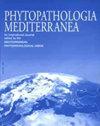Rutin-stevioside and related conjugates for potential control of grapevine trunk diseases
IF 1.9
3区 农林科学
Q2 AGRONOMY
引用次数: 3
Abstract
Flavonoids and phenolic acids play roles in grapevine defence against pathogens causing grapevine trunk diseases (GTDs). Rutin is a major flavonoid in vegetative organs of the grapevines, and this compound, unlike other flavonoids, is non-toxic and non-oxidizable. Rutin was assayed in vitro and in vivo against two Botryosphaeriaceae taxa. The limited bioavailability of this compound was circumvented by conjugation with stevioside, a glycoside obtained from Stevia rebaudiana. Clear synergistic effects were observed for the stevioside-rutin adduct, resulting in EC50 and EC90 values of 306.0 and 714.9 μg·mL-1 against Neofusicoccum parvum and 241.6 and 457.8 μg·mL-1 against Dothiorella viticola. In greenhouse experiments, moderate inhibition of N. parvum growth and complete inhibition of D. viticola were observed. These inhibitory effects were greater than those of ferulic acid, which has been considered the most effective phenolic acid against GTDs. Conjugation with stevioside provided solubility enhancement of rutin, paving the way to the design of glycopesticides based on rutin-rich plant extracts as promising antifungals against GTDs.芦丁-甜菊苷及其偶联物对葡萄树干病害的潜在防治作用
黄酮类化合物和酚酸在葡萄抵抗病原菌中起重要作用。芦丁是葡萄藤营养器官中的一种主要类黄酮,与其他类黄酮不同,这种化合物无毒且不可氧化。研究了芦丁在体外和体内对两种芽孢藓科植物的作用。该化合物与甜菊糖苷(一种从甜菊糖中提取的糖苷)偶联,克服了其有限的生物利用度。甜菊糖苷-芦丁加合物的协同作用明显,对小褐飞虱的EC50和EC90分别为306.0和714.9 μg·mL-1,对白多硫霉的EC50和EC90分别为241.6和457.8 μg·mL-1。在温室试验中,观察到对小孢子螨生长的中度抑制和对白僵菌的完全抑制。这些抑制作用大于阿魏酸,阿魏酸被认为是对gtd最有效的酚酸。与甜菊糖苷的结合提高了芦丁的溶解度,为利用富含芦丁的植物提取物作为抗gtd的抗真菌药物设计糖农药铺平了道路。
本文章由计算机程序翻译,如有差异,请以英文原文为准。
求助全文
约1分钟内获得全文
求助全文
来源期刊

Phytopathologia Mediterranea
生物-植物科学
CiteScore
4.40
自引率
8.30%
发文量
28
审稿时长
6-12 weeks
期刊介绍:
Phytopathologia Mediterranea is an international journal edited by the Mediterranean Phytopathological Union. The journal’s mission is the promotion of plant health for Mediterranean crops, climate and regions, safe food production, and the transfer of new knowledge on plant diseases and their sustainable management.
The journal deals with all areas of plant pathology, including etiology, epidemiology, disease control, biochemical and physiological aspects, and utilization of molecular technologies. All types of plant pathogens are covered, including fungi, oomycetes, nematodes, protozoa, bacteria, phytoplasmas, viruses, and viroids. The journal also gives a special attention to research on mycotoxins, biological and integrated management of plant diseases, and the use of natural substances in disease and weed control. The journal focuses on pathology of Mediterranean crops grown throughout the world.
The Editorial Board of Phytopathologia Mediterranea has recently been reorganised, under two Editors-in-Chief and with an increased number of editors.
 求助内容:
求助内容: 应助结果提醒方式:
应助结果提醒方式:


